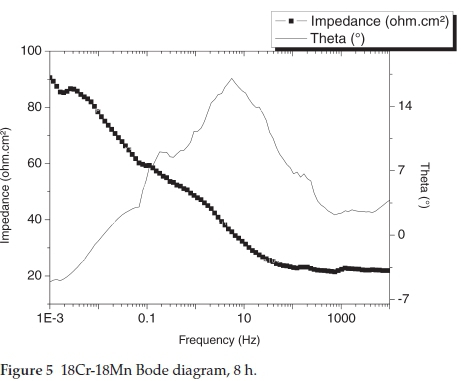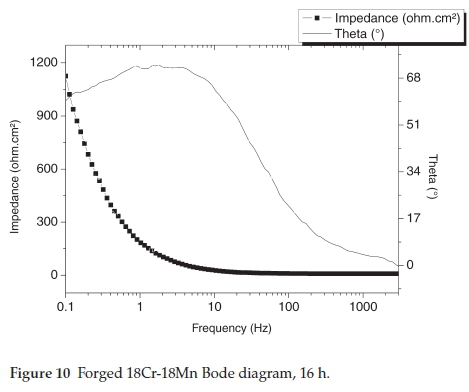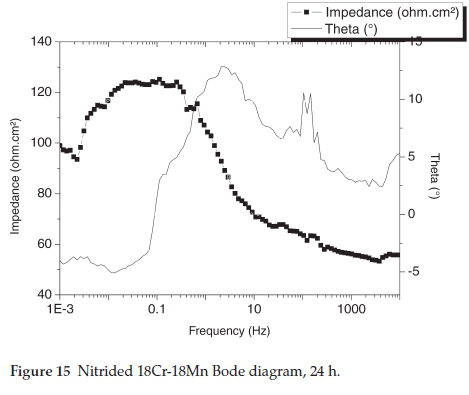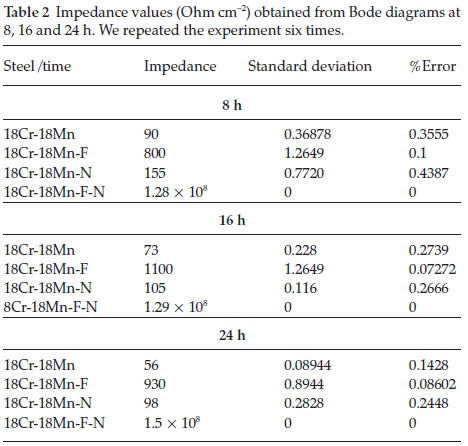Services on Demand
Article
Indicators
Related links
-
 Cited by Google
Cited by Google -
 Similars in Google
Similars in Google
Share
South African Journal of Chemistry
On-line version ISSN 1996-840X
Print version ISSN 0379-4350
S.Afr.j.chem. (Online) vol.70 Durban 2017
http://dx.doi.org/10.17159/0379-4350/2017/v70a15
RESEARCH ARTICLE
Austenite and forging effects on 18Cr-18Mn stainless steel impedance
R. Reyes-HernándezI, *; A. Torres-IslasII; S. SernaI; A. Molina-OcampoI; J. ColiII; A. BedollaIII
IUAEM, Institute of Basic Engineering and Applied Sciences (IICBA), Ad. Universidad 1001, Col. Chamilpa, 62209 Cuernavaca, Morelos, Mexico
IISchool of Chemical Science and Engineering, PE. Ing. Mechanical, Universidad Autónoma del Estado de Morelos (UAEM), Ad. Universidad 1001, Col. Chamilpa, 62209 Cuernavaca, Morelos, Mexico
IIIMetallurgical Research Institute, Universidad Michoacana de San Nicolas de Hidalgo. Gral. Francisco J. Mujica S / N Felicitas River 58030, Morelia, Michoacán, Mexico
ABSTRACT
The influence of the austenite phase (gamma iron dissolved in carbon) in the corrosion resistance of 18Cr-18Mn steel was studied. The percentage of austenite in the steel was calculated using the (Creq/Nieq) equation. In order to obtain the impedance value of the steel exposed to a corrosive saline environment, Bode diagrams were obtained at 8,16 and 24 hours of exposure. The results obtained indicate that an increase of the austenite phase in the steel, also produces an increase in various steel properties, such as steel impedance and polarization resistance (Rp). On the other hand, it was observed that the impedance value of the forged 18Cr-18Mn steel increases when the steel is immersed in a saline solution.
Keywords: Polarization resistance, austenite, Bode diagram, stainless steel, forging.
1. Introduction
Among the various phases that present in steel, there exist the austenite phase, which is gamma iron dissolved in carbon. Gamma iron forms in the 910 °C to 1400 °C range, crystallizes in a face-centred cubic crystal structure (FCC); cube gamma iron has more volume than alpha iron, dissolves more easily in carbon, and renders a nonmagnetic steel that has high ductility.1,2
These 18Cr-18mn steels are used for the retainer rings in gas turbine electric generators. This steel arose from a need for steel that is not susceptible to stress corrosion cracking (SCC).3,4 The failures in this steel are generally related to crack propagation.5 It is therefore important to determine the corrosion resistance of materials used in retainer ring manufacturing, because the rings are subject to stresses which may cause failures in generators due to rotational speed, corrosion environment and basic corrosion. Because the working environment (generalized or localized) affects steel, it is necessary to undertake basic studies to determine steel corrosion resistance and corrosion type. These steels may suffer general or localized corrosion, the main variables being the type of corrosion, corrosion rate, corrosion resistance, incremental corrosion resistance, whether or not there is the formation of a protective layer on the steel, the effect of an austenite phase, and steel constituents that may cause different behaviours. The use of different electrochemical techniques will allow better prediction of the processes involved in steel corrosion. Rawers studied six steels, namely a duplex phase (ferrite + austenite) steel, three austenite phase steels (FCC) and two aus-tenite phase (FCC) + M23C6 carbide steels,6 and could predict the phases presents in 18Cr-18mn steel using a Shauffler diagram.7
The addition of nitrogen to steel promotes its properties.8 Interstitial nitrides in steel can lead to increased cracking.9 These chromium nitrides have high stability.10
In this article we provide new information on 18Cr-18mn steel, including Bode diagrams, which indicate steel polarization resistance; this basic corrosion test has to date not been applied to 18Cr-18Mn steel.
Our work is based on an electrochemical impedance technique (EIT), which allowed us observe the increase in Z" impedance (indicative of steel corrosion resistance). EIT is an electrochemical method used in corrosion studies; it is effective and provides information on what happens to the steel during degradation (charge transfer, diffusion of species, to mention some of the mechanisms). We also provide an indication of the steel corrosion resistance.
2. Experimental Procedure
We developed four steels: 1) 18Cr-18mn steel, 2) nitriding steel 18Cr-18Mn; 3) 18Cr-18Mn forged steel, and 4) 18Cr-18Mn forged and nitrided steel. We produced the 18Cr-18mn steel in a magnetic induction furnace at the 'Instituto de Investigation en Metalurgia y Materiales' of the 'Universidad Michoacana de San Nicolas de Hidalgo', Michoacán, Mexico.
The 18Cr-18Mn steel developed by us had a new composition of analytical grade elements. The elements were melted at 1650 °C and the material was homogenized by the rotating action of the induction furnace throughout the process. The composition of the steel was 61.24 % iron, 18 % chromium, 17 % manganese, 1.8 % silicon and 1.96 % carbon.
In our electrochemical corrosion test, Bode diagrams were obtained at 8,16 and 24 h with the steel in saline solution (3.5 % NaCl in distilled water). We used an amplitude of 10 mV with a frequency range of 1 mHz to 10 KHz. We repeated the experiment six times.
For nitriding steel, we nitrided the 18Cr-18Mn steel via plasma, using a mixture of nitrogen and hydrogen gasses (20:80, respectively) over a period of 8 h with 300 V of potential and 0.12 A of current. We maintained a constant pressure (3 Torr) inside the chamber.
For forging, we raised the steel temperature to 1100 °C in a muffle and forged it at constant pressure.
The presence of the austenite stability phase in the steel was determined by applying the equation (Creq/Nieq), and this was confirmed by X-ray diffraction.
The nitrogen concentration in the nitrided steel was determined by scanning electron microscopy (SEM).
From our electrochemical test (Bode diagrams), we could determine the level of steel polarization resistance at 8,16 and 24 h while keeping the steel in a corrosive medium.
Finally we calculated the steel corrosion rates.
3. Results and Discussion
3.1. Austenite Phase Presence in Steel
For 18Cr-18mn steel, the chromium and nickel equivalents were determined using Equations 1 and 2.7

For 18Cr-18mn steel, Cr equivalent = 20.7 and Ni equivalent = 73.59.
Thus:
(Creq/Nieq) = 20.7/73.59 = 0.2812,
which indicated that our 18Cr-18Mn steel was in the stainless steel range. The low value (Creq/Nieq) indicated that in this solidification type of steel the austenite phase is unchanged, and that the steel is in a stable state.
For 18Cr-18mn nitrided steel, Cr eq = 20.7 and Nieq = 83.67.
Thus:
(Creq/Nieq) nitrided steel = 20.7/83.67 = 0.2474,
which indicated than the austenite phase of steel that was nitrided is even more stable than 18Cr-18Mn steel, because by reducing the resulting numerical value (Creq/Nieq), the stability of the austenite phase is increased. Several researchers have found a similar relationship between this behaviour and the addition of nitrogen.
The XRD study was performed with reference to international tables of crystallography (Figs. 1-4).




3.2. Corrosion Rate and Bode Diagrams
Corrosion rate to linear polarization (LPR) tests showed that the 18Cr-18Mn steel's corrosion rate was 2397.3 μm yr-1 compared to, 555.5 μm yr-1 for nitrided steel, 859.09 μm yr-1 for forged steel, and 1.818 x 00-3 μm yr-1 for forged and subsequently nitrided steel. These results are consistent with those of potentiodynamic polarization.11
From Table 1 we can conclude that the forged and nitrided 18Cr-18mn steel is the only one that presents a negligible corrosion rate.

Nitrogen increments the austenite phase in the steel. Hartline found than austenitic steels are more resistant to pitting corrosion than duplex steels, and more resistant than ferritic steels, which is an additional factor in the properties of austenitic steels.12 Zhang et al. found cell Cr2N and Chi phase, in which they attributed the increase in resistance to the bite of austenitic nitrided steel.13
Figures 5, 6, 7 and 8 show the impedance values our steels, which is related to corrosion resistance, at 8 h. The value for forged-nitrided 18Cr-18mn is the largest; this steel has an extremely high corrosion resistance value compared to the other three steels. Mandi found expanded austenite (protective white layer) and to this he attributed the high corrosion resistance of nitrided steel.14 Toshkov et al. also mentioned corrosion resistance properties because expanded austenite formed due to nitrides.15 This agrees with our corrosion rate as the rate of corrosion of this steel was the one with the lowest value. Their steel that had the lowest impedance value is the 18Cr-18Mn steel, close to 90 ohms cm-2. This is consistent with our results on corrosion rate; besides, we found that this steel has a higher rate of corrosion. We repeated the experiment six times.




Figures 9-12 and 13-16 show the corrosion behaviour of the studied steels through their Bode diagrams obtained at 16 h and 24 h, respectively, of staying immersed in a saline medium. The impedance higher value was for the forged and nitrided steel. The lower impedance value was for 18Cr-18Mn steel, his impedance varies of steel that was immersed for a longer time can be ascrided to corrosion products being added to the saline solution, resulting in a change in the aggressiveness of the medium.








It is of importance to note that over time, for steels that were not forged, the impedance values usually increased, while for forged steels the impedance decreased. This may be because the corrosion products of forged steel render the medium less corrosive, while for the steel that was not forged, the corrosion products become more aggressive. This pattern leads us to conclude that since forged steel increases in corrosion resistance over time while remaining in the same saline solution, the forged corrosion products could be used as anti-corrosion materials in corrosive solutions.
We repeated the experiment six times, and the resultant impedance values are given in Table 2. Steel that was forged and later nitrided has the highest corrosion resistance, while the steel without forging and without nitriding is the least corrosion resistant. More importantly though, impedance values of steels that were forged increased in the course of the degradation time, which means that the corrosion products of forged steels act as corrosion inhibitors.

4. Conclusions
We have shown that steel that was nitrided has a lower (Creq/Nieq) value, indicating that is an austenitic stable steel, phase unchanged. The forged and nitrided 18Cr-18mn steel had the lowest corrosion value, an insignificant level of corrosion, better corrosion resistance, and also the highest impedance value according to the Bode diagrams. The great increase in impedance therefore suggest that steel should be nitrided and forged if a high impedance in saline environments is required. We also noted that the impedance of forged steel increased over time in in a saline environment, indicating that the corrosion products render the medium less aggressive over time.
Higher corrosion resistance was observed for steel that was forged and nitrided, and this is attributed to surface nitrides, chemical composition of the material, chemical stability, the ability to prevent the diffusion of metallic ions and their structural high order.
One of the most important observations with respect to forged steel is that over a period time its impedance increased due to corrosion products. With respect to the addition of nitrogen via plasma, it was observed that this greatly increased the corrosion resistance of steel due to the formation of a passive layer by the nitrides of chromium and a white layer called austenite expanded or phase 'S'
References
1 L. Bracke, J. Penning and N. Akdut, The influence of Cr and N additions on the mechanical properties of FeMnC steels, Metall. Mater. Trans. A, 2007, 38(3), 520-528. [ Links ]
2 C.W. Shao, F. Shi and X.W. Li, Influence of cyclic stress amplitude on mechanisms of deformation of a high nitrogen austenitic stainless steel, Mater. Sci. Eng. A, 2016, 667, 208-216. [ Links ]
3 O.I. Balyts'kyi, Corrosion-mechanical characteristics of the mterials of non magnetic retaining rings of turbogenerators. II high-nitrogen 18Mn-18Cr steels, Mater. Sci., 1998, 34(2), 115-122. [ Links ]
4 J. Ishizaka, Development and production of 18Cr-18Mn non-magnetic retaining ring with high yield strength, ISIJ Int., 1990, 30(8), 587-593. [ Links ]
5 S. Liu, D. Liu and S. Liu, Transgranular fracture in low temperature brittle fracture of high nitrogen austenitic steel, J. Mater. Sci. , 2007, 42(17), 7514-7519. [ Links ]
6 J. Rawers, Oxidation characteristics of Fe-18Cr-18Mn-stainless steel alloys, Oxid. Met., 2010, 74(3-4), 167-178. [ Links ]
7 J.C. Rawers, Alloying effects on the microstructure and phase stability of Fe-Cr-Mn steels, J. Mater. Sci., 2008,43(10), 3618-3624. [ Links ]
8 J. Moon, T.H. Lee, J.H. Shin and J.W. Lee, Hot working behavior of a nitrogen-alloyed Fe-18Mn-18Cr-N austenitic stainless steel, Mater. Sci. Eng. A, 2014, 594, 302-308. [ Links ]
9 H. Berns and K. Geenen, Hot strength and creep resistance of a high interstitial austenitic CrMn steel, Steel Res. Int., 2013, 84(8), 713-723. [ Links ]
10 S. Parascandola, W. Möller and D. L. Williamson, The nitrogen transport in austenitic stainless steel at moderate temperatures, 2000, Appl. Phys. Lett, 76(16), 2194. [ Links ]
11 R.R. Hernandez, A. Torres, S. Serna, A. Bedolla, A. Molina, J. Colin and H. Martinez, Corrosion behavior of 18Cr-18Mn hot forged and plasma nitrided steel, J. Adv. Electrochem. , 2016, 2(4), 117-120. [ Links ]
12 A.G. Hartline, The effect of nitrogen additions upon the pitting resistance of 18PctCr,18PctMn stainless steel, Metall. Trans. 1974,5,5-10. [ Links ]
13 H.B. Li, Z.H. Jiang, Z. Li and Z.R. Zhang, Pitting susceptibility and semiconducting properties of passive films of 18Cr-18Mn-2Mo-0.9N high nitrogen austenitic stainless steel, Adv. Mater. Res. , 2009, 79-82, 993-996. [ Links ]
14 S. Maändl and B. Rauschenbach, Anisotropic strain in nitrided austenitic stainless steel, J. Appl. Phys. , 2000, 88(6), 3323. [ Links ]
15 V Toshkov, R. Russev, T. Madjarov, and E. Russeva, On low temperature ion nitriding of austenitic stainless steel AISI316, JAMME, 2007, 25(1), 71-74. [ Links ]
Received 14 December 2016
Revised 5 July 2017
Accepted 17 July 2017
* To whom correspondence should be addressed. E-mail: r.i.c204@hotmail.com














